|
...back to Aburi
Sunday
January 4 2004
Cape Coast and the Slave Castle
Cape coast
- The village
A three hour bus tour to the west of Accra will bring you to cape
coast. Located on the ocean, the town if very hilly and most of
the shanty houses are tightly packed along the hillside, in an almost
Victorian era like way.
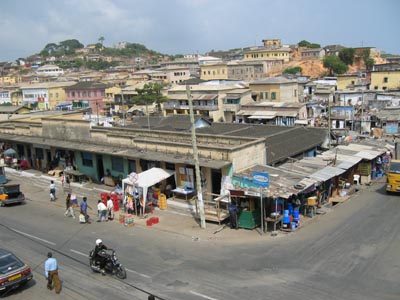
This is a view of cape coast from up high. It is a picturesque,
almost Victorian style town on a hill.
Like Accra, Cape Coast is very much a strange soup of underdeveloped/developed
and African/European influences. It's almost surreal in a way.
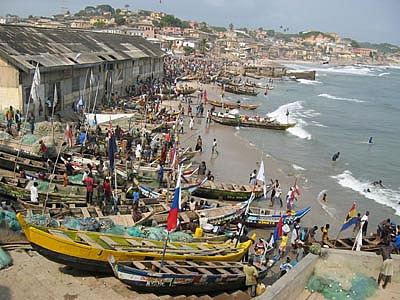
This picture is taken from the cape coast slave castle. Just meters
from the slave castle is cape castle's thriving fishing community,
and children playing freely in the waves.
The
slave castle - A history
This is most strongly felt in the presence of the cape coast slave
castle. This castle is truly an experience. The castle is located
on a rocky coast, with the waves splashing violently up against
the sides. On either side of the castle is beach, with the east
side serving as a bustling fishing community launch point. One can
stand on the top of the castle, look down and see people gutting
fish, selling oranges, children playing in the waves right in the
shadow of what some people have called the greatest evil in history,
the slave trade.
Estimates for the number of slaves that were traded off the west
coast of Africa range from 12 million to 25 million. This makes
for the largest involuntary ethnic dispersion in history. About
a third of the slaves went to South America, a third to Portugal,
and a third to North America.
They were used to man plantations of sugar cane, cotton etc...
Which were dominating the world trade market. But this was tough
work, thus the slaves came into play. There was what was called
the "trade triangle" which a boat would travel, taking
from 18 Months to 3 years. The boat would be made and manned in
Europe. It would be filled with fabrics, jewellery, and weapons.
These items would be taken to the west coast of Africa to be traded
for slaves. The slaves would then taken be sold to the plantations
in the Americas. From there the boat would pick up the finished
goods farmed by the slaves and cart it back to Europe. From there
it would load back up with fabric, jewellery and arms to return
to Africa for slaves. Thus, the great "slave triangle".
Majestic horror
The cape coast castle is one of two nearly fully preserved slave
castles, the other in Elmina about 30km away, both on the coast
of Ghana. It is truly a testament to the horrors of the slave trade.
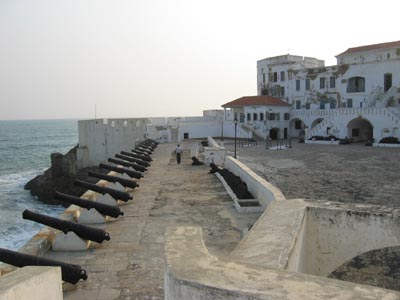
This is the courtyard of the cape coast castle. The canons in front
would be filled with solid cannonballs that could fire 2km and put
a hole in a ship to sink it. The Smaller morter cannons (against
the small wall) would contain larger cannonballs filled with gunpowder
that would travel 3km and explode on contact, igniting a ship into
flames.
One is first struck by the how majestic the castle is. There are
many upper chambers, and cannons overlooking the most vulnerable
walls. There is even a church on the grounds... directly above the
male slave dungeon.
Slave dungeons
The entrance to the male slave dungeon is exactly as the entrance
to any dungeon is portrayed in the movies, a dark must curved archway
leading down into the depths.
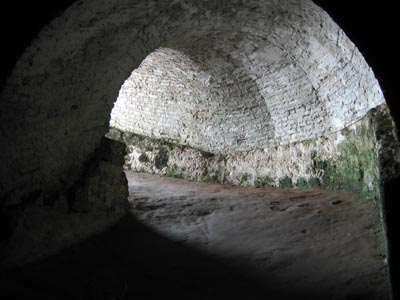
Descending into the slave dungeons...
There are five sections to the dungeons, 4 of the more or less
the same. My estimates could be quite a bit off, but they were probably
about 10m x 5m, and had an arched ceiling about 6 meters up. About
five meters up the wall of a cell was a small window, about a food
high and half as wide which was the sole supply of air and light
to the room. The entire set of chambers was sloped downwards, with
a small track in the middle through which excrement and urine would
flow.
200 slaves would be housed in each of these rooms.
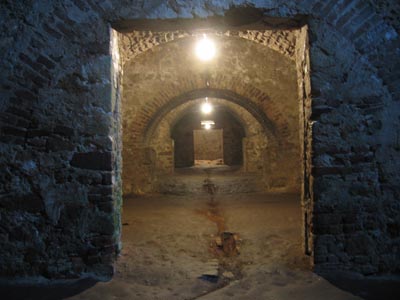
You can see the excrement tract that traverses downhill through
the middle of the dungeons. The floor is not brick, it is petrified
excrement and human remains.
People would of course die regularly in the inhumane conditions;
malaria and malnutrition were usually what did them in the end.
There were second opening in the chambers, from which 'domestic'
slaves to the castle would check periodically to see if anybody
had died and needed to be removed.
The ground is made of brick, but you cannot see it because there
is a thick stone like hard layer above it. That layer is the remnant
of humans bodies, blood, and excrement that pounded down hard enough
by the number of slaves in the room to turn it rock hard. I walked
on this floor.
The fifth room was reserved for the trouble makers, the ones who
tried to agitate the crowds or try to escape. It was a maximum security
cell. Holes could be seen on the walls where they were chained in
a standing position, and the people were packed even more tightly
that in the other cells.
The female slave dungeon was not too much different. There were
only two rooms, but there were not as many women because they were
not seen to be as useful for farming fields. The two rooms held
500 women.
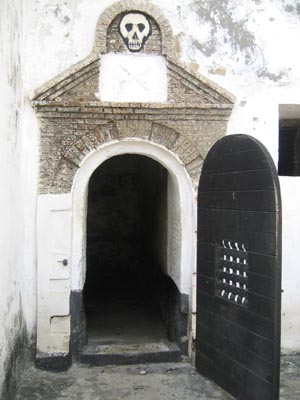 |
On the side of a courtyard was another chamber. There were
a series of three doors that would seal off the hallway entrance.
Inside there was no hole for light or ventilation entry. With
the doors closed the room would be in complete darkness. The
sick, weak, and especially troublesome slaves would be sent
to this room without food or water to starve, suffocate and
die.
The door pictured here is actually from the Elmina slave
castle, but it served the same purpose. As you can see the
slave traders weren't shy about the death they were dealing
out. |
This never took more than two days before the bodies were removed
and thrown into the ocean.
The gate of no return
When it was time for the slaves to be shipped out, they would be
marched through a long tunnel under the castle to the entry port
to the boats. The slaves that didn't decide to die in their homeland
by throwing themselves into the ocean were shipped off, never aware
even of their destination. The boat backed them like cargo, one
on top of another. Of course many atrocities followed on the journey
and once they landed in the Americas, but this is the story of the
castle.
The large port door that led out of the castle into the boats was
labelled (by the museum management) "The gate of no return".
Slaves would be forever separated from their families and roots
and often not live much longer.
The gate of return
Once the slave trade was abolished, the tunnel under the castle
that led to the door of no return was sealed on both ends, symbolically
representing the end of slave transfer, and to prevent corrupt people
from sneaking in and continuing the use of the castle. In the Americas,
two slaves who had died were taken back to the castle, and taken
back through the door of no return to represent slavery would not
in fact be the hopeless end of the African people. Thus, from the
other side of the gate, there is a sigh that now reads "The
gate of return".
Closing thoughts...
It is hard to know exactly what to make of the Slave castle, with
it’s pristinely clean dungeons and the first urinal I have seen
since I got to Africa (I still have yet to see a public bathroom
in Togo), while simultaneously considering it’s hideous history.
In all, it’s definitely a trip worth taking.
back to top
On to Elmina...
|







